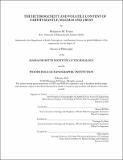The heterogeneity and volatile content of Earth's mantle, magmas and crust
Author(s)
Urann, Benjamin M.(Benjamin Macy)
Download1251926989-MIT.pdf (46.76Mb)
Other Contributors
Joint Program in Oceanography/Applied Ocean Science and Engineering.
Massachusetts Institute of Technology. Department of Earth, Atmospheric, and Planetary Sciences.
Woods Hole Oceanographic Institution.
Advisor
Henry J.B. Dick and Veronique Le Roux.
Terms of use
Metadata
Show full item recordAbstract
This thesis explores the volatile content of the mantle, subducted oceanic crust, and arc magmas as well as the structure of slow spreading ocean crust and the heterogeneity of Earth's upper mantle. In Chapter 2, I directly explore the halogen (F and Cl) content of mantle minerals in situ, then use these measurements to assess the halogen content of the upper mantle. In Chapter 3, I investigate the volatile content of Raspas eclogites (SW Ecuador), a proxy for deeply subducted oceanic crust, to evaluate volatile transfer from crustal generation at divergent plate boundaries (e.g., mid-ocean ridges) to recycling of ocean crust at subduction zones. In Chapter 4, I use the H₂O content of nominally anhydrous minerals in plutonic arc cumulates to elucidate the H₂O content of the melts from which the rocks crystallized. In this way, I assert that primitive arc magmas may contain 4-10 wt.% H₂O and through fractional crystallization up to ~20 wt.% H₂O, making them far more hydrous than traditional methods (i.e., olivine-hosted melt inclusions) surmise. In Chapter 5, I show that mantle peridotite exposed along the 16°N region of the Mid-Atlantic Ridge originated in an arc setting and has been remixed into subridge mantle, indicating that the sub-ridge mantle is more heterogeneous and depleted than inferences made from mid-ocean ridge basalts suggest. Chapter 6 surveys the life cycle of oceanic core complexes through zircon geochronology and posits an updated framework for understanding the termination of oceanic core complexes, and more broadly oceanic detachment faults. Together, this contribution highlights the chemical heterogeneity of the mantle, and quantifies the full extent of volatiles hosted by mantle and crustal reservoirs.
Description
Thesis: Ph. D., Joint Program in Oceanography/Applied Ocean Science and Engineering (Massachusetts Institute of Technology, Department of Earth, Atmospheric, and Planetary Sciences; and the Woods Hole Oceanographic Institution), February, 2021 Cataloged from the official PDF of thesis. Includes bibliographical references (pages 153-169).
Date issued
2021Department
Joint Program in Oceanography/Applied Ocean Science and Engineering; Massachusetts Institute of Technology. Department of Earth, Atmospheric, and Planetary Sciences; Woods Hole Oceanographic InstitutionPublisher
Massachusetts Institute of Technology
Keywords
Joint Program in Oceanography/Applied Ocean Science and Engineering., Earth, Atmospheric, and Planetary Sciences., Woods Hole Oceanographic Institution.